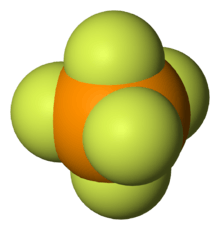Phosphorus pentafluoride
 | |
 | |
| Names | |
|---|---|
| IUPAC name
Phosphorus pentafluoride | |
| Other names
Phosphorus(V) fluoride Pentafluoridophosphorus Pentafluorophosphorane | |
| Identifiers | |
3D model (JSmol) |
|
| ChemSpider | |
| ECHA InfoCard | 100.028.730 |
| EC Number | 231-602-3 |
PubChem CID |
|
| RTECS number | TH4070000 |
| UN number | 2198 |
| |
| |
| Properties | |
| PF5 | |
| Molar mass | 125.966 g/mol |
| Appearance | colourless gas |
| Odor | unpleasant |
| Density | 5.527 kg/m3 (g/L) |
| Melting point | −93.78 °C (−136.80 °F; 179.37 K) |
| Boiling point | −84.6 °C (−120.3 °F; 188.6 K) |
| hydrolysis | |
| Structure | |
| trigonal bipyramidal | |
| 0 D | |
| Hazards | |
| Flash point | Non-flammable |
| Related compounds | |
Other anions |
Phosphorus pentachloride Phosphorus pentabromide Phosphorus pentaiodide |
Other cations |
Arsenic pentafluoride Antimony pentafluoride Bismuth pentafluoride |
Related compounds |
Phosphorus trifluoride |
Except where otherwise noted, data are given for materials in their standard state (at 25 °C [77 °F], 100 kPa). | |
| Infobox references | |
Phosphorus pentafluoride, PF5, is a phosphorus halide. It is a colourless, toxic gas that fumes in air.[1][2]
Preparation
Phosphorus pentafluoride was first prepared in 1876 by the fluorination of phosphorus pentachloride using arsenic trifluoride, which remains a favored method:[1]
- 3 PCl5 + 5 AsF3 → 3 PF5 + 5 AsCl3
Structure
Single-crystal X-ray studies indicate that the PF5 has trigonal bipyramidal geometry. Thus it has two distinct types of P−F bonds (axial and equatorial): the length of an axial P−F bond is distinct from the equatorial P-F bond in the solid phase, but not the liquid or gas phases due to Pseudo Berry Rotation.
Fluorine-19 NMR spectroscopy, even at temperatures as low as −100 °C, fails to distinguish the axial from the equatorial fluorine environments. The apparent equivalency arises from the low barrier for pseudorotation via the Berry mechanism, by which the axial and equatorial fluorine atoms rapidly exchange positions. The apparent equivalency of the F centers in PF5 was first noted by Gutowsky.[3] The explanation was first described by R. Stephen Berry, after whom the Berry mechanism is named. Berry pseudorotation influences the 19F NMR spectrum of PF5 since NMR spectroscopy operates on a millisecond timescale. Electron diffraction and X-ray crystallography do not detect this effect as the solid state structures are, relative to a molecule in solution, static and can not undergo the necessary changes in atomic position.
References
- 1 2 W. Kwasnik "Phosphorus(V) fluoride" in Handbook of Preparative Inorganic Chemistry, 2nd Ed. Edited by G. Brauer, Academic Press, 1963, NY. Vol. 1. p. 190.
- ↑ Greenwood, Norman N.; Earnshaw, Alan (1997). Chemistry of the Elements (2nd ed.). Butterworth-Heinemann. ISBN 0-08-037941-9.
- ↑ Gutowsky, H. S.; McCall, D. W.; Slichter, C. P. (1953). "Nuclear Magnetic Resonance Multiplets in Liquids". J. Chem. Phys. 21 (2): 279. doi:10.1063/1.1698874.